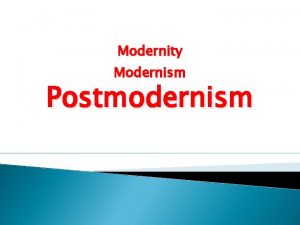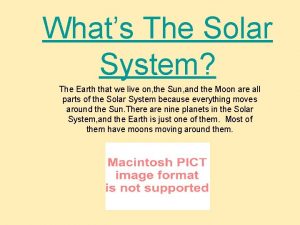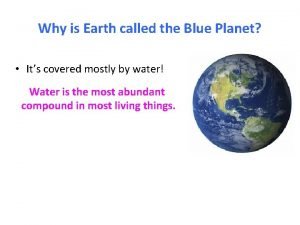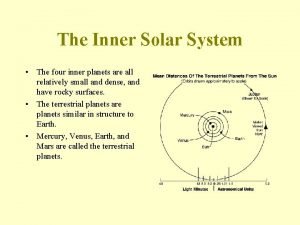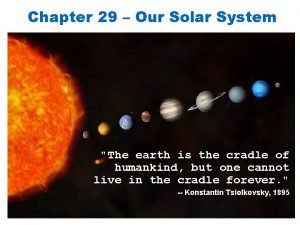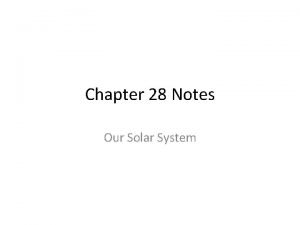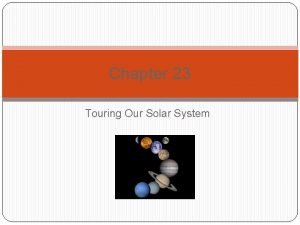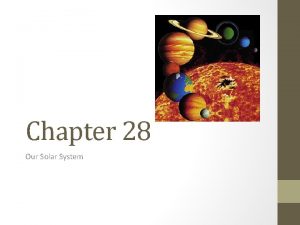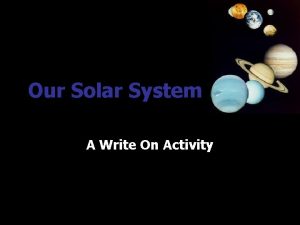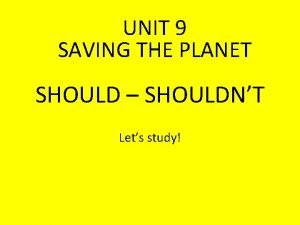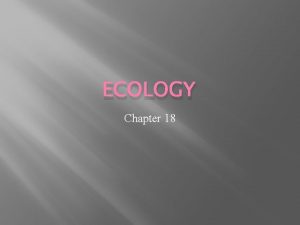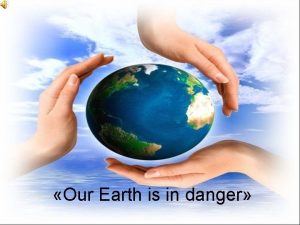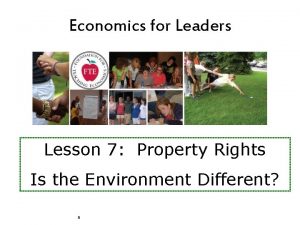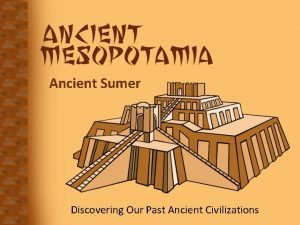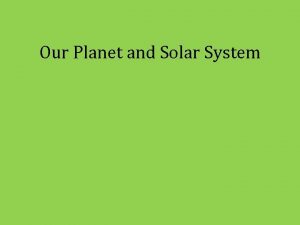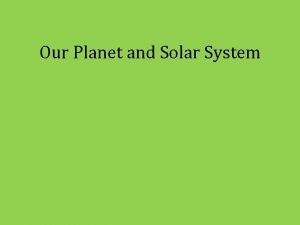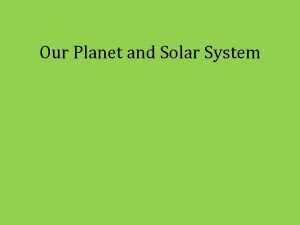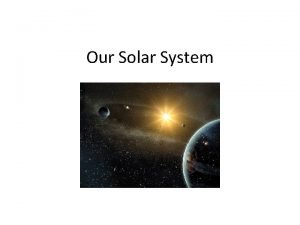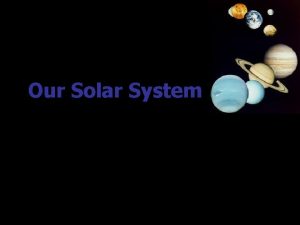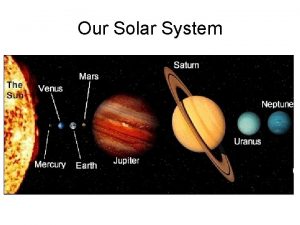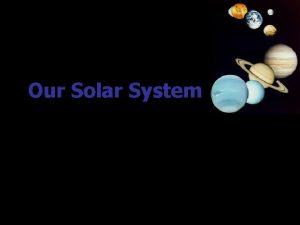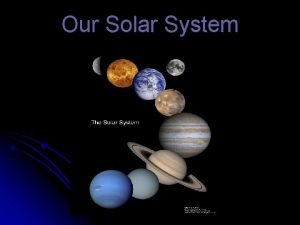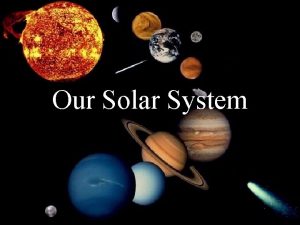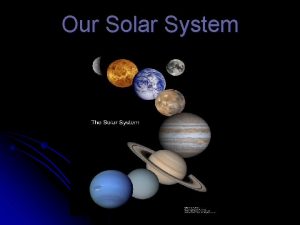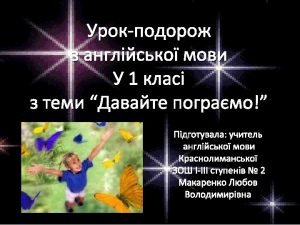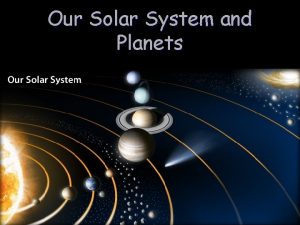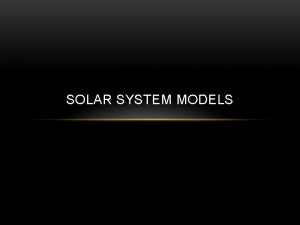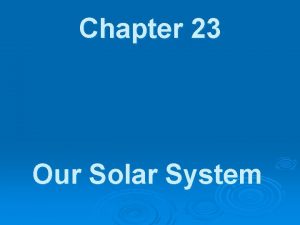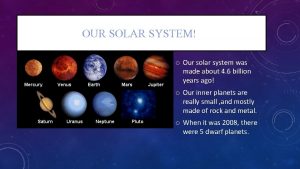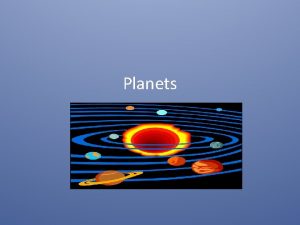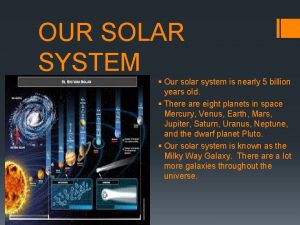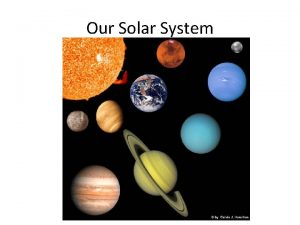Our Planet and Solar System Ancient and PreModern

































- Slides: 33

Our Planet and Solar System

Ancient and Pre-Modern Theories of the Universe/Solar System • Aristotle’s theory of four elements • Astronomy and Astrology exist • But Heavens are considered to be a separate realm from earthly objects



Geocentric vs. Heliocentric Models • Geocentric Model – Places Earth at the center of the universe – Objects in Heavens (planets, Sun, stars) are fixed crystalline “spheres, ” nested around Earth – Big achievement: it explained the motion of the Sun, moon, planets, and stars. • Established c. 500 B. C.


– Based on: • Observations • Belief that the heavens must be geometrically “perfect. ” – Ptolemy c. A. D. 100 -170 • Combined others’ work to create a quantitative model • Used circles within circles • Was fairly accurate for the time

Problems with Geocentrism • Circles within circles inelegant (or imperfect) • Didn’t explain phases of the moon • These problems not considered big enough to push alternative theory

Nicholas Copernicus (1473 -1543) • Used a heliocentric model of the solar system • Proposed by a Greek astronomer Aristarchus in 260 B. C. • Copernicus applied math to the data (which wasn’t all that good) • Even though more correct, still assumed perfect circles • predictions weren’t much better than the geocentric model.

Tycho Brahe (1546 -1601) • Took really good data and tons of it.

Tycho Brahe (1546 -1601) • Was funded by the king of Denmark and then the German emperor. • Had an island observing station • Died without knowing whether he had made any breakthroughs.

• Brahe was convinced other planets orbited the Sun, but concluded (b/c he couldn’t detect stellar parallax) that Earth must remain stationary.

Johannes Kepler (1571 -1630) • Worked for Tycho • Approached the data mathematically, assuming circular orbits. • After 8 years, found a mathematical model for a circular orbit of Mars that almost matched Tycho’s observations. There was a difference of 8 minutes of arc.

His “aha” moment: “If I had believed that we could ignore these eight minutes [of arc], I would have patched up my hypothesis accordingly. But, since it was not permissible to ignore, those eight minutes pointed the road to a complete reformation in astronomy. ” • This decision to trust the data over his preconceived beliefs marked an important transition point in the history of science.

• Kepler discovered that the planets did not orbit in circles, but rather ellipses. • Even through Kepler’s model made much better predictions, many scientists still believed in the geocentric model. – Earth couldn’t be moving, otherwise birds and thrown rocks would be left behind. – Non-circular orbits meant heavens weren’t perfect

Galileo Galilei (1564 -1642) • Demonstrated Newton’s 1 st law before Newton was even born (in 1642…) • Firm believer in scientific inquiry – Remember our pendulum experiment?

Galileo Galilei (1564 -1642) • Demonstrated Newton’s 1 st law before Newton was even born (in 1642…) • Saw sunspots on the sun – so now the Sun isn’t perfect • Saw topography (mountains) on the moon – So the Moon isn’t perfect either • Discovered that Jupiter has moons that orbit it – Clearly don’t revolve around the Earth • Aristotle’s doctrines considered part of Catholic Church doctrine. • Galileo persecuted by church for publishing his results late in life


The imperfections just pile up. . .

Phases of the Moon

Retrograde Motion – Planets switch directions in their paths in the sky



Phases of the Moon • Key ideas – ½ the Moon is always lit. – The Moon reflects the Sun’s light. – We aren’t seeing different sides of the Moon, what is changing is what is lit. • There is no one “dark side of the Moon. ” – Period of about 27 days. – Phases are due to Moons orbit around the Earth – Moon rises and sets due to the rotation of the Earth.

Eclipses • Two types – Lunar eclipse • Earth is directly between the Sun and Moon – Earth’s shadow falls on the Moon • Can only be seen at night – Solar eclipse • Moon is directly between Sun and Earth – Moon’s shadow falls on the Earth • Can only be seen during the day





Seasons

Our Solar System • What was evidence for Geocentrism? • What was evidence for Heliocentrism?

Comets and Minor Planets

Extra-solar Planets
 Post modernism timeline
Post modernism timeline How many days are in saturn's year
How many days are in saturn's year [email protected]
[email protected] Whats the biggest planet in the solar system
Whats the biggest planet in the solar system Which planet is called the blue planet
Which planet is called the blue planet The four inner planets
The four inner planets Chapter 29 our solar system
Chapter 29 our solar system Chapter 28 our solar system
Chapter 28 our solar system Chapter 23 touring our solar system
Chapter 23 touring our solar system Chapter 28 our solar system
Chapter 28 our solar system Write about our solar system
Write about our solar system What do you do to protect the environment
What do you do to protect the environment Studying our living planet
Studying our living planet Our planet is in danger
Our planet is in danger Captain planet he's our hero
Captain planet he's our hero Buy wholesale solar panels
Buy wholesale solar panels Solar energy is free. solar is inexhaustible
Solar energy is free. solar is inexhaustible Pictures of ancient and modern means of communication
Pictures of ancient and modern means of communication Ancient india vs ancient china
Ancient india vs ancient china Awareness of ourselves and our environment is
Awareness of ourselves and our environment is Awareness of ourselves and our environment
Awareness of ourselves and our environment Our awareness of ourselves and our environment.
Our awareness of ourselves and our environment. Our awareness of ourselves and our environment
Our awareness of ourselves and our environment Discovering our past ancient civilizations
Discovering our past ancient civilizations Thinking affects our language, which then affects our:
Thinking affects our language, which then affects our: Our census our future
Our census our future Longing for peace our world is troubled
Longing for peace our world is troubled Our life is what our thoughts make it
Our life is what our thoughts make it We bow our hearts we bend our knees
We bow our hearts we bend our knees Our census our future
Our census our future Our life is what our thoughts make it
Our life is what our thoughts make it Our collective madness is for *
Our collective madness is for * God our father christ our brother
God our father christ our brother Our future is in our hands quotes
Our future is in our hands quotes
